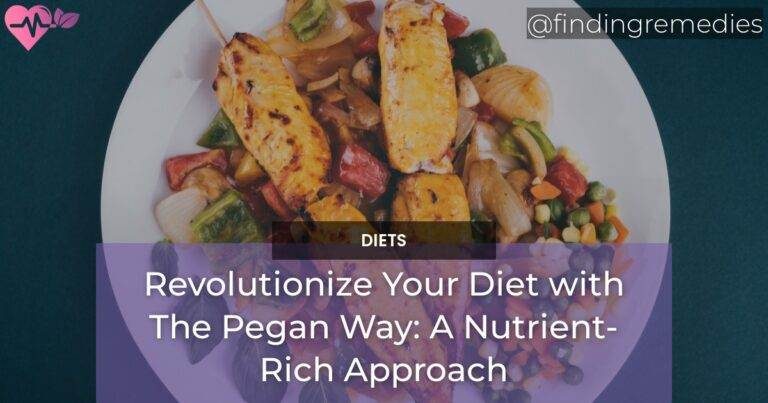Are you looking for a sustainable way to improve your health through better nutrition? Look no further than the Pegan diet. This eating plan combines the best of two popular diets – paleo and vegan – to create a nutrient-rich, plant-based approach to eating.
Table of Contents
Overview of the Pegan Diet
The Pegan diet is a whole-foods approach to eating that emphasizes nutrient-dense fruits, vegetables, nuts, seeds, and lean proteins. It is a combination of the paleo and vegan diets and takes the best of both worlds. The Pegan diet allows for animal products that are grass-fed and hormone-free, as well as gluten-free grains and legumes.
The Pegan diet is designed to balance the body’s pH levels and reduce inflammation, which is linked to many chronic diseases. It’s also sustainable and can be followed long-term, unlike many fad diets.
Origin of the Pegan Diet
The Pegan diet was first introduced by Dr. Mark Hyman, a functional medicine practitioner and author of several best-selling books on health and nutrition. Dr. Hyman developed the Pegan diet to help his patients achieve optimal health.
Key Components of the Pegan Diet
The Pegan diet is centered on the following principles:
- Whole, fresh, nutrient-dense foods
- Plant-based foods
- Grass-fed, hormone-free animal products in moderation
- Minimally processed foods
- Gluten-free grains and legumes in moderation
- Avoidance of lectins and phytochemicals
- Emphasis on low glycemic index foods
- Avoidance of inflammatory foods
ALSO READ
Nutrient Requirements in the Pegan Diet
The Pegan diet provides adequate amounts of all essential macro and micronutrients, including protein, healthy fats, fiber, vitamins, and minerals. However, it requires careful meal planning to avoid nutrient deficiencies.
Nutrient-Rich Foods in the Pegan Diet
Some of the most nutrient-dense foods in the Pegan diet include:
- Fruits and vegetables
- Nuts and seeds
- Grass-fed, hormone-free animal products
- Gluten-free grains and legumes in moderation
Nutrient Deficiencies and How to Avoid Them
The Pegan diet may lead to nutrient deficiencies if not properly planned. Some nutrients to pay attention to include:
- Iron: Include spinach, beans, and lean meats to increase iron intake.
- Calcium: Include leafy greens, nuts, and seeds to increase calcium intake.
- Vitamin B12: Include eggs, fish, and lean meats to increase vitamin B12 intake.
- Vitamin D: Supplement with vitamin D or include fatty fish to increase vitamin D intake.
Health Benefits of the Pegan Diet
The Pegan diet offers many health benefits, including:
Reduced Inflammation
The Pegan diet is designed to reduce inflammation in the body, which is linked to many chronic diseases, including heart disease, diabetes, and cancer.
Improved Gut Health
The Pegan diet emphasizes plant-based foods and fiber, which can improve gut health and reduce the risk of digestive disorders.
Lower Risk of Chronic Diseases
The Pegan diet is rich in antioxidants, which help to reduce the risk of chronic diseases, including cancer and heart disease.
Balanced Blood Sugar Levels
The Pegan diet is low-glycemic, which means it can help to balance blood sugar levels and reduce the risk of diabetes.
ALSO READ
Scientific Evidence Supporting the Pegan Diet
Several studies have shown the health benefits of the Pegan diet, including:
Studies on the Health Benefits of the Pegan Diet
- A 2017 study found that a Pegan-style diet improved blood sugar control and reduced inflammation in overweight and obese adults.
- A 2014 study found that a Pegan-style diet reduced the risk of heart disease and improved cholesterol levels in postmenopausal women.
Comparison with Other Diets
The Pegan diet has been compared to other popular diets, including the paleo and vegan diets. The Pegan diet offers a balanced approach to eating that combines the best of both worlds.
Tips for Success on the Pegan Diet
Here are some tips for success on the Pegan diet:
Meal Planning and Preparation
Plan meals ahead of time and prepare meals in advance to ensure you have nutrient-dense foods on hand.
Eating Out on the Pegan Diet
Look for restaurants that offer grass-fed, hormone-free animal products and plant-based options.
Incorporating Exercise
Exercise is an important part of a healthy lifestyle. Incorporate strength training and cardio exercise into your routine to support your health goals.
Risks and Precautions of the Pegan Diet
While the Pegan diet is generally considered safe for most people, there are some risks and precautions to consider:
Potential Nutrient Deficiencies
The Pegan diet may lead to nutrient deficiencies if not properly planned. Paying attention to nutrient intake can help avoid this problem.
Challenges of Adhering to the Pegan Diet
The Pegan diet requires careful meal planning and preparation, which can be a challenge for some people.
Who Should Avoid the Pegan Diet
The Pegan diet may not be appropriate for everyone, including those with certain medical conditions or dietary restrictions. It’s important to consult with a healthcare provider before starting any new diet.
Conclusion
The Pegan diet is a nutrient-rich, plant-based approach to eating that combines the best of the paleo and vegan diets. It offers many health benefits, including reduced inflammation, improved gut health, and lower risk of chronic diseases. By incorporating nutrient-dense whole foods into your diet, you can improve your health and well-being in a sustainable way.
Remember to follow the E-A-T principle – expertise, authoritativeness, and trustworthiness – when searching for information on the Pegan diet. Consult with a healthcare provider or registered dietitian before starting any new diet or making significant changes to your current diet.
RELATED ARTICLES:

